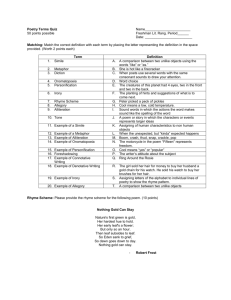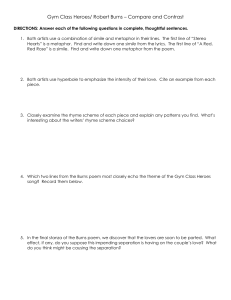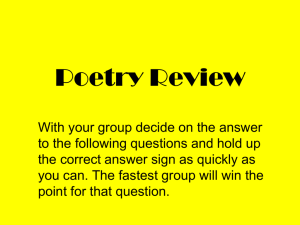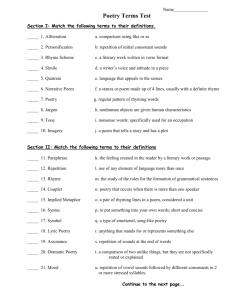Poetic Devices
advertisement
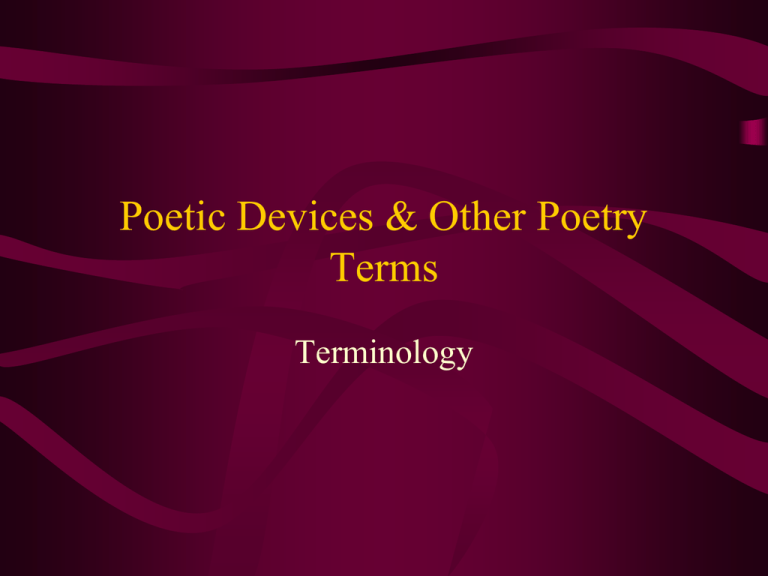
Poetic Devices & Other Poetry Terms Terminology Analogy • A comparison; in poetry, the most common analogies are similies and metaphors. Simile • A comparison of two things that are not alike, by using comparison words such as “like”, “as” or “than” to show how similar they are • Example: She is busy as a bee. • Ex. He is meaner than a rattlesnake Metaphor • Comparison of two different things as if they were the same, but without using comparison words such as “like” or “as” • Example: My brother is such a bear! You decide… Simile, metaphor or neither? • My love is like a red, red rose. You decide… Simile, metaphor or neither? • The darling dachshunds are mean bolts of lightning, yapping at anything that comes near. You decide… Simile, metaphor or neither? • The moon is a white frisbee floating over the mountain. You decide… Simile, metaphor or neither? • I’m hungry as a horse. You decide… Simile, metaphor or neither? • Oh my gosh! Your feet are boats! You decide… Simile, metaphor or neither? • I’m so tired that I feel like I could sleep forever. You decide… Simile, metaphor or neither? • Sunshine is God’s fingers tickling your face. You decide… Simile, metaphor or neither? • Her hair is brighter than a field of golden wheat. Your turn… • Write 2 examples that are similes. • Write 2 examples that are metaphors. Symbol • Something concrete (real or touchable) that represents an idea or feeling • Examples: – Eagle = Freedom – Red Rose = Love Imagery • Words and phrases that paint a picture in the mind of the reader. They contain vivid verbs and descriptors. • Ex. The dogs are on the basement stairs and coming up. • Their eyeballs roll, • their blond legs burn like brush. Repetition When a poet repeats the same word or phrase to emphasize a certain part of a poem. For example, musicians use the ‘chorus’ of a song to repeat a certain part that is important. I.E. In Eminem’s “Lose Yourself” he repeats: You better lose yourself in the music, the moment You own it, you better never let it go You only get one shot, do not miss your chance to blow This opportunity comes once in a lifetime yo, Alliteration • The repetition of the beginning SOUND or letter in two or more words in a line of poetry. • Examples: – Dappled doggies dash – Suzy sold seashells down by the seashore – Phony fillies flaunted their phenomenal tails. Assonance • The repetition of a VOWEL sound in two or more words within a line of poetry. • Examples: – Do you like blue? (the oooo sound) – My dear, it’s good to hear you ate the potato peel. – My bud likes butter only on his spuds. Onomatopoeia • A word that mimics the sound it represents (it actually sounds like the sound it makes) • Examples: – Swish, Hiss, Zip, Ding Dong, Quack Hyperbole • Hyperbole – an exaggeration • As the Tilt-a-Whirl started spinning, Jackie held on tighter than a tick on a dog’s ear. Personification • giving human qualities to a nonhuman thing • Toby knew he couldn’t put off his homework much longer. His algebra book seemed to stare at him, whisper to him, call out his name, demanding his attention. Stanza • A ‘paragraph’ in a poem. Couplet • Two rhymed lines of poetry. • We strolled alongside the beautiful bay • The sun wished us a wonderful day. End Rhyme/External Rhyme • Rhyming patterns of words at the end of two or more lines of a poem. • Example: – Humpty Dumpty sat on a wall – Humpty Dumpty had a great fall – – – – I want to know why when I’m late For school, they get into a state. But if invited out to tea I mustn’t ever early be. Rhyme Scheme • a pattern of rhyme in a poem, that is repeated the same in every stanza. – – – – Bid me to weep, and I will weep, While I have eyes to see; And having none, yet I will keep A heart to weep for thee. "A" "B" "A" "B" Slant Rhyme (Half Rhyme) • words that are used to create a rhyme scheme that are similar in spelling, and look to rhyme, but are pronounced differently. The poem MUST have a regular rhyme pattern to have slant rhyme. • Example: slaughter and laughter – – – – At once a voice arose among The bleak twigs overhead In a full-hearted even song Of joy illuminated; Internal Rhyme • rhyming of words within a line of poetry (NOT at the end of the lines) • Examples: – Jack Sprat could eat no fat – The wind was nipping and clipping at my face – The sails of noon left off their tune Free Verse • Poetry that is free from fixed patterns of either rhyme or beat/rhythm. • Example: If I were in charge of the world I’d cancel oatmeal, Monday mornings, Allergy shots, and also Curfews Your turn again… • Poetry Fire Drill!! Rhythm & Meter • The basic rhythmic structure of poetic verse (the basic sing-song sound that occurs when poetic verse is spoken). Da-du, da-du, da-du, da-du… • Meter is measured in ‘feet’ with one foot being two syllables in length. • 1 foot—I am • 2 feet—The sun will shine • 5 feet—Shall I compare thee to a summer’s day? Pattern Poetry • Poems written so that the words form a certain pattern; some examples are: limerick, diamonte, concrete (shape) poetry, etc. Sonnet • A 14-line poem, written in 3 stanzas of 4 lines each, with a couplet at the end, with a specified rhyme scheme. • The most famous is the Shakespearean Sonnet, which is written in ABAB, ABAB, ABAB, CC rhyme scheme, with an iambic pentameter rhythm.
